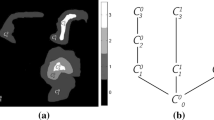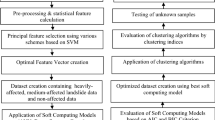Abstract
The October 8, 2005, Kashmir earthquake (M w 7.6) affected the rough mountainous regions of India and Pakistan with poor accessibility, and thus, no proper comprehensive ground survey was possible. However, due to the ability of remote sensing technology to acquire spectral measurements of damaged areas at various spatial and temporal scales, extraction of damaged areas can be carried out quickly and with great reliability. The fuzzy-based classifiers [Possibilistic c-Means (PCM), noise cluster (NC), and NC with entropy (NCE)] were applied to identify 2005 Kashmir earthquake, induced landslides, as well as built-up damage (BD) areas, as soft computing approaches using supervised classification. Results indicate that for the identification of landslides and BD areas, NCE classifier generated the best outputs, while for the identification of built-up undamaged areas, NC classifier generated the best output. Further, it was found that the proposed Class Based Sensor Independent (CBSI) technique can improve spectral information of specific class for better identification.





Similar content being viewed by others
References
Baugh WM, Groeneveld DP (2006) Broadband vegetation index performance evaluated for a low-cover environment. Int J Remote Sens 27(21):4715–4730
Bezdek JC (1981) Pattern recognition with fuzzy objective function algorithm. Plenum, New York. ISBN 978-1-4757-0452-5
Binaghi E, Brivio PA, Chessi P, Rampini A (1999) A fuzzy set based accuracy assessment of soft classification. Pattern Recognit Lett 20(9):935–948
Birth GS, McVey G (1968) Measuring the color of growing turf with a reflectance spectroradiometer. Agron J 60(6):640–643
Brier GW, Allen RA (1951) Verification of weather forecasts, compendium of meteorology. In: Malone T (ed) American Meteorological Society, pp 841–848
Broge NH, Leblanc E (2000) Comparing Predicting Power and Stability of Broadband and Hyperspectral vegetation Indicies for Estimation of green area index and canopy Chlorophyl density. Remote Sens Environ 76(2):156–172
Chen X, Vogelmann JE, Rollins M, Ohlen D, Key CH, Yang L, Huang C, Shi H (2011) Detecting post-fire burn severity and vegetation recovery using multitemporal remote sensing spectral indices and field-collected composite burn index data in a ponderosa pine forest. Int J Remote Sens 32(23):7905–7927
Dash P, Voss F, Singh RP (2000) Anomalous stress pattern in Chamoli region observed from IRS-1B data. Curr Sci 78(9):1066–1070
Dave RN (1991) Characterization and detection of noise in clustering. Pattern Recognit Lett 12(11):657–664
Dunn JC (1974) Well separated clusters and optimal fuzzy partitions. J Cybern 4(1):95–104
Eitel JUH, Long DS, Gessler PE, Hunt ER (2008) Combined spectral index to improve ground-based estimates of nitrogen status in dryland wheat. Agron J 100(6):1694–1702
Foody GM, Lucas RM, Curran PJ, Honzak M (1997) Non-linear mixture modeling without end-members using an artificial neural network. Int J Remote Sens 18(4):937–953
Gao BC (1996) NDWI-a normalized difference water index for remote sensing of vegetation liquid water from space. Remote Sens Environ 58(3):257–266
Hamid D, Hassan G (2006) Measurement of uncertainty by the entropy: application to the classification of MSS data. Int J Remote Sens 27(18):4005–4014
Harp EL, Crone AJ (2006) Landslides triggered by the October 8, 2005, Pakistan earthquake and associated landslide-dammed reservoirs: USGS open-file report, p 1052
Huete AR (1988) A soil-adjusted vegetation index (SAVI). Remote Sens Environ 25(3):295–309
Jensen JR (2005) Introductory digital image processing: a remote sensing perspective, 3rd edn. Prentice-Hall, Upper Saddle River, p 526
Kamp U, Growley BJ, Khattak GA, Owen LA (2008) GIS-based landslide susceptibility mapping for the 2005 Kashmir earthquake region. Geomorphology 101(4):631–642
Klir GJ (1990) A principle of uncertainty and information variance. Int J Gen Syst 17(2–3):249–275
Krishnapuram R, Keller JM (1993) A possibilistic approach to clustering. IEEE Trans Fuzzy Syst 1(2):98–108
Kumar KV, Martha TR, Roy PS (2006) Mapping damage in the Jammu and Kashmir caused by 8 October 2005 Mw 7.3 earthquake from Cartosat-1 and Resourcesat-1 imagery. Int J Remote Sens 27(20):4449–4459
Massone AM, Masulli F, Petrosini A (2000) Fuzzy clustering algorithms and landsat images for detection of waste areas: a comparison, in advances in fuzzy systems and intelligent technologies. Shaker, Maastricht, pp 165–175
Miyamoto S, Ichihashi H, Honda K (2008) Algorithms for fuzzy clustering: methods in c-means Clustering with Applications. Springer, New York. ISBN 978-3-540-78737-2, 46-66
Owen LA, Kamp U, Khattak GA, Harp EL, Keefer DK, Bauer MA (2008) Landslides triggered by the October 8, 2005, Kashmir earthquake. Geomorphology 94(1–2):1–9
Parsons T, Yeats RS, Yagi Y, Hussain A (2006) Static stress change from 8 October, 2005 M = 7.6 Kashmir earthquake. Geophys Res Lett 33(6):1–4
Pradhan B, Singh RP, Buchroithner MF (2006) Estimation of stress and its use in evaluation of landslide prone regions using remote sensing data. Adv Space Res 37(4):698–709
Pradhan B, Youssef AM, Varathrajoo R (2010) Approaches for delineating landslide hazard areas using different training sites in an advanced artificial neural network model. Geo Spat Inf Sci 13(2):93–102
Rouse JW, Haas RH, Schell JA, Deering DW (1973) Monitoring vegetation systems in the Great Plains with ERTS. Third ERTS symposium, NASA SP-351-I, pp 309–317
Saba SB, Meijde MVD, Werff HVD (2010) Spatiotemporal landslide detection for the 2005 Kashmir earthquake region. Geomorphology 124(1–2):17–25
Sato HP, Hasegawa H, Fujiwara S, Tobita M, Koarai M, Une H, Iwahashi J (2007) Interpretation of landslide distribution triggered by the 2005 Northern Pakistan earthquake using SPOT 5 imagery. Landslides 4(2):113–122
Sellers PJ, Meeson BW, Hall FG, Asrar G, Murphy RE, Schiffer RA, Bretherton FP (1995) Remote sensing of the land surface for studies of global change: models, algorithms-experiments. Remote Sens Environ 51(1):3–26
Sengar SS, Kumar A, Ghosh SK, Wason HR, Roy PS (2012) Liquefaction identification using class based sensor independent approach based on single pixel classification after 2001 Bhuj, India earthquake. J Appl Remote Sens 6(1):1–15. doi:10.1117/1.JRS.6.063531
Sengar SS, Kumar A, Ghosh SK, Wason HR (2013a) Earthquake induced built-up damage identification using IRS-P6 data—a comparative study using fuzzy based classifiers. Geocarto Int. doi:10.1080/10106049.2012.756939
Sengar SS, Kumar A, Ghosh SK, Wason HR, Raju PLN, Krishnamurthy YVN (2013b) Study of soft classification approaches for identification of earthquake induced liquefied soil. Geomat Nat Hazards Risk. doi:10.1080/19475705.2013.811444
Shafique M, Meijde MVD, Ullah S (2011) Regolith modeling and its relation to earthquake induced building damage: a remote sensing approach. J Asian Earth Sci 42(2):65–75
Tso B, Mather PM (2009) Classification methods for remotely sensed data. CRC Press, Boca Raton, pp 56–69
Tucker CJ (1979) Red and photographic infrared linear combinations for monitoring vegetation. Remote Sens Environ 8(2):127–150
Wang J, Price KP, Rich PM (2001) Spatial patterns of NDVI in response to precipitation and temperature in the Central Great Plains. Int J Remote Sens 22(18):3827–3844
Acknowledgments
The authors are thankful to learned reviewers and Chief Editor, “Natural Hazards” for their critical remarks, valuable guidance and comments in improving the manuscript.
Author information
Authors and Affiliations
Corresponding author
Rights and permissions
About this article
Cite this article
Sengar, S.S., Ghosh, S.K., Kumar, A. et al. Earthquake damage identification: a case study using soft classification approach. Nat Hazards 71, 1307–1322 (2014). https://doi.org/10.1007/s11069-013-0956-8
Received:
Accepted:
Published:
Issue Date:
DOI: https://doi.org/10.1007/s11069-013-0956-8




